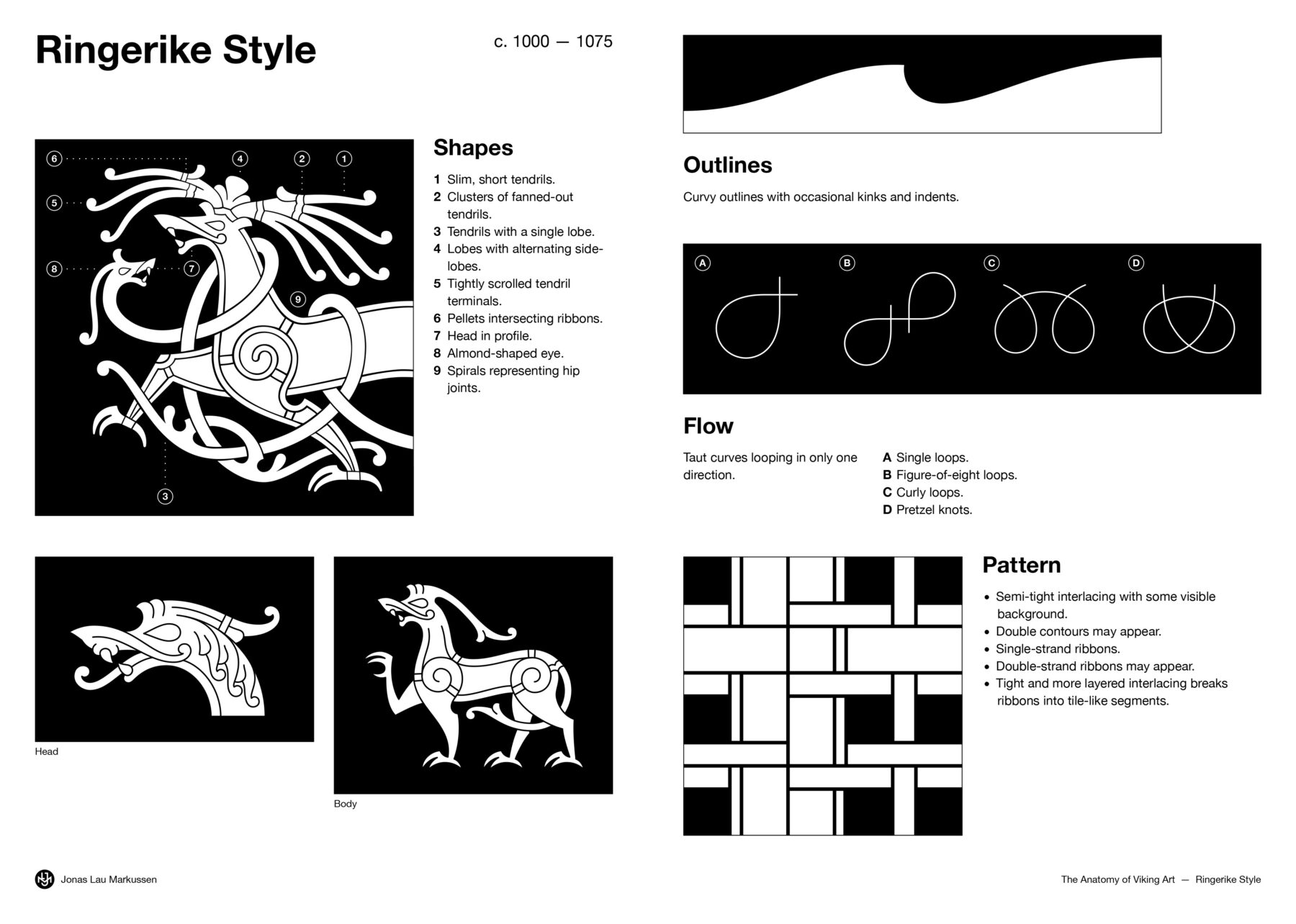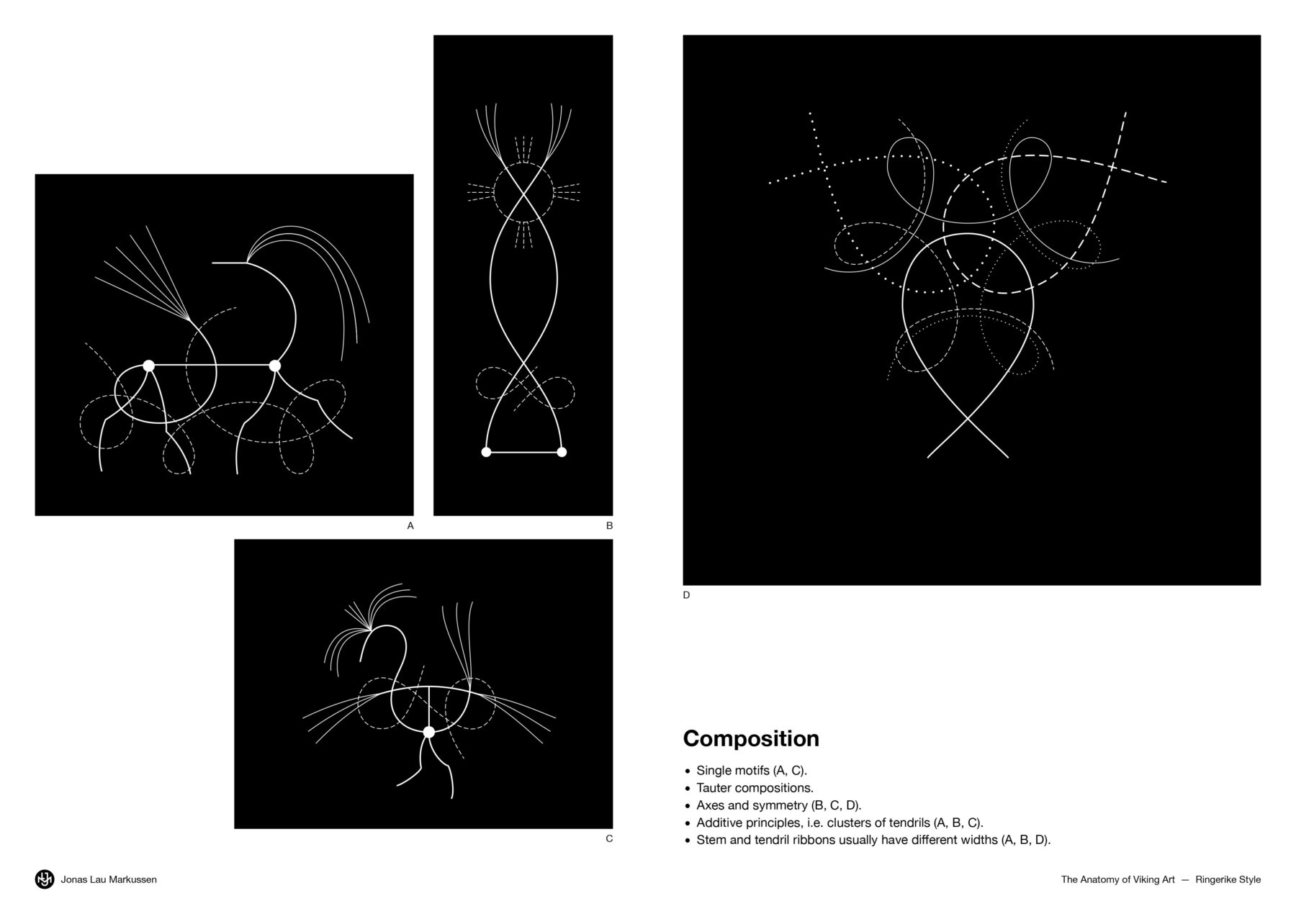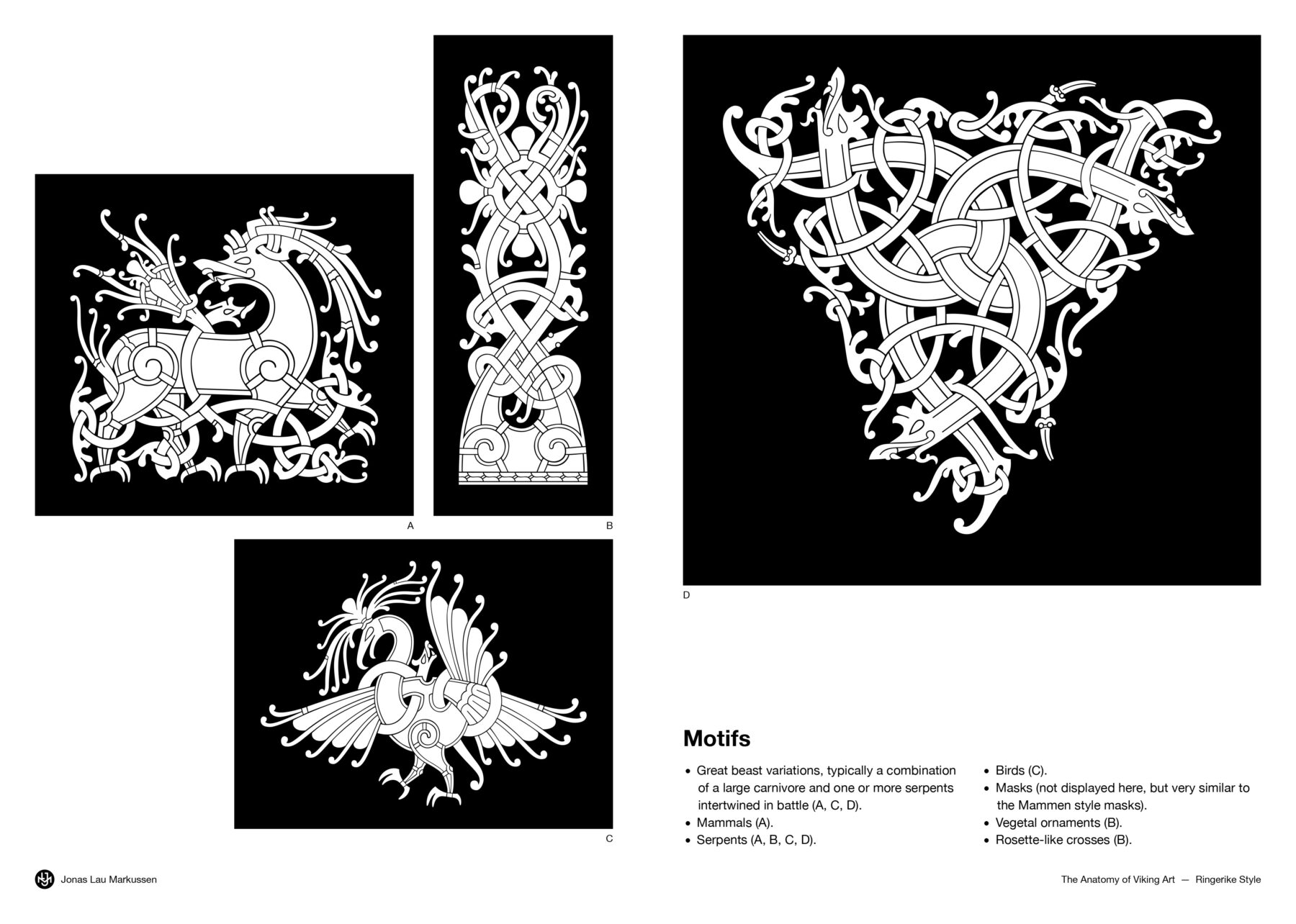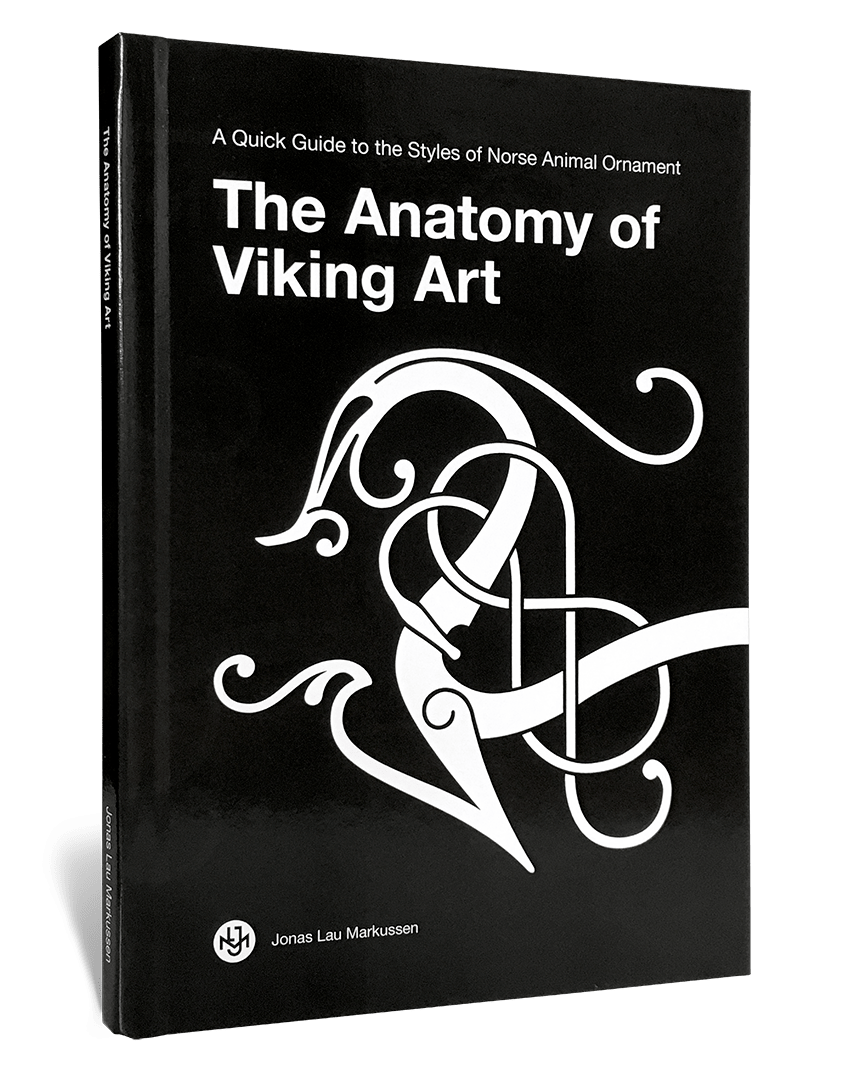
Ringerike style
December 20, 2016
The Anatomy of Viking Art
- Introduction
- Broa Style
- Oseberg Style
- Borre Style
- Jelling Style
- Mammen Style
- Ringerike Style
- Urnes Style
The Anatomy of the Ringerike Style
c. 1000 – 1075
Shapes
1. Slim, short tendrils.
2. Clusters of fanned-out tendrils.
3. Tendrils with a single lobe.
4. Lobes with alternating side-lobes.
5. Tightly scrolled tendril terminals.
6. Pellets intersecting ribbons.
7. Head in profile.
8. Almond-shaped eye.
9. Spirals representing hip joints.
Outlines
Curvy outlines with occasional kinks and indents.
Flow
Taut curves looping in only one direction.
A. Single loops.
B. Figure-of-eight loops.
C. Curly loops.
D. Pretzel knots.
Pattern
- Semi-tight interlacing with some visible background.
- Double contours may appear.
- Single-strand ribbons.
- Double-strand ribbons may appear.
- Tight and more layered interlacing breaks ribbons into tile-like segments.
Composition
- Single motifs (A, C).
- Tauter compositions.
- Axes and symmetry (B, C, D).
- Additive principles, i.e. clusters of tendrils (A, B, C).
- Stem and tendril ribbons usually have different widths (A, B, D).
Motifs
- Great beast variations, typically a combination of a large carnivore and one or more serpents intertwined in battle (A, C, D).
- Mammals (A).
- Serpents (A, B, C, D).
- Birds (C).
- Masks (not displayed here, but very similar to the Mammen style masks).
- Vegetal ornaments (B).
- Rosette-like crosses (B).
Rise and Fall of the Great Norse Kingdom
The Conquest of England
King Æthelred the Unready paid the third Danegeld to Sweyn Forkbeard. But, owing to rumours of an assassination attempt against him, Æthelred then slaughtered a large number of the Norse settlers in what has since been known as the St. Brice’s Day massacre. In retaliation, Sweyn raided England three consecutive times, before he and his son Cnut the Great finally conquered the kingdom. However, this was a very short-lived victory for Sweyn, who died a few weeks after.
Expansion and Subjugation
After Sweyn’s death, his youngest son, Harald II, became king of Denmark, Norway and Sweden. Cnut was proclaimed King of England, but was exiled to Denmark. He returned the following year with a fleet, and regained control over England by defeating Æthelred’s son, Edmund Ironside, in the Battle of Assandun. A few years later, when his brother Harald II died, Cnut seized control over Denmark, Norway and Sweden. The Scottish king also submitted to him, and Cnut was now king of the largest Norse empire ever, earning him the title, Cnut the Great. While Cnut was occupied in England, Olof Haraldson tried to seize the throne of Norway, but his attempt was futile, and he was ultimately killed in the Battle of Stiklestad.
Division of the Kingdom
When Cnut eventually died, his empire was divided into smaller kingdoms. Magnus the Good, son of Olof Haraldson, and therefore a legitimate heir to the Norwegian crown, although exiled to Novgorod, was placed on the throne of Norway at the age of 11. Harold Harefoot, son of Cnut, inherited the throne of England, and Cnut’s other son, Harthacnut, became king of Denmark. Harthacnut eventually seized control of England a few short years later, when his brother Harold died. But it was not long before he too succumbed, ultimately ending the Norse rule of England for good. After Harthacnut’s death, Denmark was ruled by Norwegian King Magnus the Good for a few years.
A Blossoming of Foliate Ornaments
Development
The characteristics of the Ringerike style directly extend the Mammen style, from which it may often be difficult to differentiate. The development of this style draws further inspiration from Western European sources. The use of foliate motifs is intensified. The style displays intertwining tendrils inspired by Frankish conventions, alternating lobes and tendrils of British origin, and leaf-terminals inspired by acanthus leaves, which were popular in both the Frankish and British regions. But the style is still inherently Norse. All external influences were modelled to fit Scandinavian traditions and conventions, where the motif of the great beast introduced in the Mammen era increased in popularity, and many variations appear, particularly on the many new runestones erected at this time.
Dating
With the gradual introduction of Christianity to Scandinavia, goods no longer accompanied the dead to their graves. Therefore, dating relies almost exclusively on metalwork found in hoards that included coins, but may be reasonably well-established.
Runestones
Only a dozen stone sculptures had been erected in Scandinavia before the Greater Jelling Stone, except for the Gotland picture stones. The power centred around the Jelling dynasty was probably the driving factor behind the development of this style: with its connections to the Church, the direct cultural influences must have had an impact, also reflected in the style. The runestones, inspired by the Jelling stone, became quite popular, and it is from this time we see the most runestones erected in Scandinavia, with Uppland, Sweden being the innovative centre. The influence of English stone carvers is evident, and the craft may have been brought back to Scandinavia with the Norse settlers. The Ringerike style is the only Viking Age style that is not named after an actual find location. Instead, it is named after the area of Ringerike, a little north of Oslo, the source of the sandstone of which many of the runestones are made.
Weather Vanes
Some of the most magnificent examples of this style are three weathervanes from Norway and Sweden. Originally, they were metal standards or flags on ships’ mastheads or prows, but survived because they were adapted and used as weathervanes on churches, and remained in use almost until modern time. Wooden Staffs The wooden staffs found in Lund and Dublin also deserve special mention here, because of their splendid animal-head terminals, reminiscent of the animal-head posts of the Oseberg grave.
Distribution
The Ringerike style was widespread throughout Scandinavia and all the Norse settlements, particularly in the British Isles, where it inspired many of the local styles, and even found great popularity in the Irish regions, were it was extensively adopted and, among other things, directly inspired a few manuscripts. It continued to be used in this region even after it faded and transitioned to the Urnes style in Scandinavia.
Ringerike – Examples
Examples on Gelmir.com →
A list of examples with photos, info and links to sources.
Dateable
c. 1026 – 1030
Arm ring with animal-head terminal — the Undrom Hoard
Undrom, Ångermanland, Sweden.
Historiska Museet, Stockholm, 108822.
c. 1048
Round brooch — the Espinge Hoard
Espinge, Skåne, Sweden.
Historiska Museet, Stockholm, 108124.
Undateable
Animal-head staff — Fishable Street
Dublin, Ireland.
National Museum of Ireland, Dublin E172:5587.
Animal-head staff — Stora Södergatan
Lund, Skåne, Sweden.
Kulturen, Lund KM 59.126:795.
Animal-shaped brooch — Munkevang *
Munkevang, Sjælland, Denmark.
Nationalmuseet, København, D 905/2019.
Animal-shaped brooch — Tamdrup *
Tamdrup, Jylland, Denmark.
Nationalmuseet, København, D254/2016.
Animal-shaped brooch — Rossvang *
Rossvang, Jylland, Denmark.
Nationalmuseet, København, D 100/2021.
Arm ring with animal-head terminals
Lilla Rone, Gotland, Sweden.
Historiska museet, Stockholm, 113673.
Axe *
Botnhamn, Troms og Finnmark, Norway.
UiT Norges arktiske universitetsmuseum, Tromsø, Ts11937.
Bird-shaped brooch — Hillerslev *
Hillerslev, Jylland, Denmark.
Nationalmuseet, København, D 806/2018.
Bird-shaped brooch — Trellerupgaard *
Trellerupgaard, Fyn, Denmark.
Nationalmuseet, København, D 1008/2018.
Bird-shaped brooch — Østervandet I *
Øster Vandet, Jylland, Denmark.
Nationalmuseet, København, D 76/2011.
Bird-shaped brooch — Østervandet II *
Øster Vandet, Jylland, Denmark.
Nationalmuseet, København, D 50/2012.
Bone pin
Thames, London, England.
The British Museum, London, 1893,0618.72.
Disc brooch — the Hornelund Hoard
Hornelund, Jylland, Denmark.
Nationalmuseet, Copenhagen C7144.
Figurine *
Rällinge, Södermanland, Sweden.
Historiska museet, Stockholm, 109037.
Plaque *
Hammersmith, London, England.
The British Museum, London, 1904,0623.4.
Runebommehammer *
Rendalen, Innlandet, Norway.
Universitetets Oldsaksamling, Oslo, C26831/a.
Runestone DR 284 *
Hunnestad, Skåne, Sweden.
Runestone DR 285 *
Hunnestad, Skåne, Sweden.
Runestone DR 314
Allehelgons Kirke, Lund, Skåne, Sweden.
Now Universitetsbiblioteket Lund.
Runestone E2
The St Paul’s Churchyard, London, England.
Museum of London, London 4075.
Runestone N 61, N 62
Alstad, Oppland, Norway.
Now Kulturhistorisk Museum, Oslo.
Runestone N 68
Dynna, Innlandet, Norway.
Runestone N 84
Vang, Oppland, Norway.
Runestone Sö 101
Ramsundsberget, Mora, Södermanland, Sweden
Runestone Vg 4
Stora Ek, Västergötland, Sweden.
Runestone Vg 181
Frugården, Norra Åsarp, Västergötland, Sweden.
Stone slab fragments
City of London, England.
The British Museum, 1883,1219.1, 1883,1219.2.
Sword — Egge *
Egge, Trøndelag, Norway.
NTNU Vitenskapsmuseet, Trondheim, T20362.
Weather Vane — Heggen
Heggen, Buskerud, Norway.
Universitetets Oldsakssamling, Oslo, C23602.
Weather Vane — Källunge
Källunge, Gotland, Sweden.
Gotlands Museum, Visby, GFC4413.
Weather Vane — Söderala
Söderala, Hälsingland, Sweden.
Historiska Museet, Stockholm, 106752.
Weather Vane Animal *
Lolland, Denmark.
Nationalmuseet, København, D12128.
Woodcarvings — Flatatunga
Flatatunga, Northwestern Region, Iceland.
Þjóðminjasafn Íslands, Reykjavík 15296 a-c.
Woodcarvings — Gaulverjabær
Gaulverjabær, Southern Region, Iceland.
Þjóðminjasafn Íslands, Reykjavík 1974:217.
* Examples added to the list in 2023.
Runestones
Runestone Style Pr 1 (Ringerike Style Proper)
Runestone Style Pr 2 (Late Ringerike Style)
Runestone Style B-e-v (Contemporary with Pr 1 and Pr 2)
Examples removed from the list in 2023
- Disc brooch — the Årstad Hoard. Årstad, Rogaland, Norway.
- Disc brooch — the Gerete Hoard. Gerete, Fardhem, Gotland, Sweden. Historiska Museet, Stockholm.
- Bronze rim mount. Aarhus, Jylland, Denmark. Nationalmuseet, Copenhagen C9487.
- Gilt silver bronze plate. Winchester, England. Winchester Cathedral Library.
- The Gök Stone (Gökstenen). Härad, Södermanland, Sweden, Sö 327.
- The Tullstorp Stone. Tullstorp, Scania, Sweden, DR 271.
Reclassified in 2023
- Crucifix. Bonderup, Sjælland, Denmark. Nationalmuseet, København, 32222. → Urnes style.
- Bird-shaped brooch. Gresli Nordre, Trøndelag, Norway. NTNU Vitenskapsmuseet, Trondheim, T2042. → Urnes style.
- Ivory head of a tau crozier. Veszprémvölgy, Hungary. → Urnes style.
Litterature
Graham-Campbell, James, 2013. Viking Art.
Fuglesang, Signe Horn, 1980. Some Aspects of the Ringerike Style.
Fuglesang, Signe Horn, 1981. ‘Stylistic Groups in Late Viking and Early Romanesque Art.’ Acta ad Archaeologiam et Artium Historiam Pertinentia (Series altera in 8°) 79–125.
Anne-Sofie Gräslund, 2001. Dating the Swedish Viking-Age rune stones on stylistic grounds.
Jörn Stäecker, 2006. Decoding Viking art, The Christian iconography of the Bamberg Shrine.





